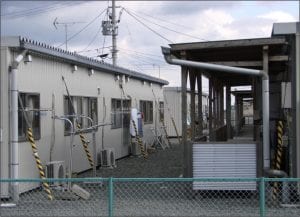Humanitarian shelter and home-based work
By Victoria Maynard, on 7 July 2022
The future of humanitarian response is urban. More specifically, the future of humanitarian response is in informal settlements in urban areas in the Global South. In these contexts 20-50% of households run small home-based enterprises from within or around their home. It is also estimated that home-based enterprises generate 50-75% of household incomes. Home-based enterprises can take many forms. They can be as simple as a table or chair—from which to cook, sew or provide haircuts; or the use of a room or window to make or sell goods and services. They include kiosks and extensions, to the use of a whole floor of a home for a shop, café, or workshop.
Despite the prevalence and importance of home-based enterprises to households living in informal settlements, they remain largely overlooked within the humanitarian shelter and settlements sector. The latest edition of the Sphere Handbook (2018) states that shelters must be “located to provide access to livelihoods opportunities” which should be “close to the shelter”. Similarly, Shelter Projects Essentials (2021) includes a diagram which states that shelter should be “near my work”. However, for many families their home is itself the place where they earn a living—so shelter recovery plays a critical role in their ability to restart their livelihoods.
In addition, if we ignore home-based enterprises then we are ignoring women. Most home-based enterprises are run by women and at least 50% more women work in households with home-based enterprises than those without. We are also missing a massive opportunity to help women restart their livelihoods. In 2005 Sheppard and Hill argued that home-based enterprises are “the single most important income source for the populations most affected by disaster”. While the contribution of shelter to home-based enterprises is “the most important way that shelter can support economic development in post-disaster societies”.

5 years after the Indian Earthquake Ocean and Tsunami in Aceh, Indonesia, a woman uses the porch of her reconstructed home as a shop. Source: Maynard et al 2014.
Recognising the importance of this topic, in 2021 Beth Simons, Elizabeth Wagemann, and I published a chapter on ‘Supporting the Recovery of Home-Based Enterprises’ in the Roadmap for Research for Humanitarian Shelter and Settlements Assistance. In April 2021 we hosted a breakout group at UK Shelter Forum 27, during which participants shared lots of examples from practice. These included: using porches as small shops or places of work; using the space around shelters for growing crops for sale; using the space inside the shelter for making crafts; and using the roof for food storage. One participant commented that “every single woman” in a project in Burkina Faso was engaged in home-based enterprise and “most of the requests for housing improvements are linked to those activities”.
We have since completed a scoping study to examine the relationship between housing and home-based work (HBW) in development contexts. The study considered (1) The effects of housing on HBW and (2) The effects of HBW on housing. 1837 potentially relevant studies were identified in academic and grey literature and 12 studies from Latin America and the Caribbean (LAC) were then selected for further study. Each of the LAC studies were read and coded, using a combination of inductive and conductive approaches. Results were then presented in terms of: effects identified at household or settlement scale; and those identified in multiple studies with consistent findings, multiple studies with inconsistent findings, and single studies.
Our results reaffirmed the “symbiotic relationship” between housing and HBW—with livelihood and household activities taking place at different times of the day in the same space. We also found that households are more likely to engage in HBW if they:
- Live in advantageous locations within the city, neighbourhood, or building;
- Are subject to favourable regulation (or lack of regulation);
- Do not feel at risk from natural hazards or security threats;
- Live in larger houses on larger plots, with adequate appliances and services;
- Have greater tenure security.
We suggest that these can be called the characteristics of ‘supportive housing and settlements’. In settlements where these characteristics are present more households are likely to engage in HBW. Households which engage in HBW develop more sustainable and resilient livelihoods—as a result of increased financial assets and greater diversity of income sources. Income from HBW is often invested in housing improvements such as purchasing appliances, installing services, or improving the quality or quantity of space in or around the home. Improvements like these in turn generate more supportive housing conditions, enabling the household to sustain, expand or diversify their HBW.
While these results are based on literature from development contexts, they are relevant to humanitarian shelter and settlement programming. For example, is the type and prevalence of HBW included in vulnerability and capacity assessments? Do humanitarian shelter programmes allow enough space within and around shelters to allow households to engage in HBW? Do they enable households to take on HBW to finance shelter self-recovery or build their long-term resilience? Do they consider the positive contribution of HBW to meeting the day-to-day needs of their communities? Or do restrictive policies, regulations, and lack of tenure security limit the ability of households to engage in HBW?
Our next steps are to: gather empirical evidence from humanitarian contexts in LAC; compare the results of the LAC scoping study with the documents we found from other continents; and undertake a broader literature review to investigate the relationship between HBW and shelter recovery and/or resilience in humanitarian contexts. Join us at the Shelter Meeting in Geneva (or online) on Friday 8th July for an update on our ongoing research in LAC or join our mailing list for future updates.
Victoria Maynard is a PhD Student in the UCL Department of Civil, Environmental and Geomatic Engineering (UCL CEGE).
 Close
Close






